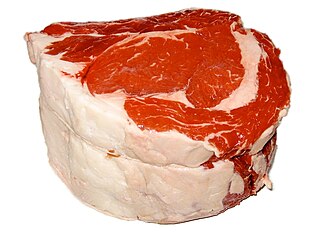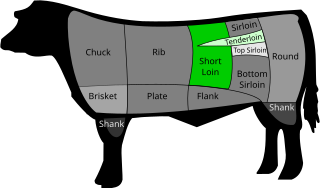
Beef is the culinary name for meat from cattle.

A beefsteak, often called just steak, is a flat cut of beef with parallel faces, usually cut perpendicular to the muscle fibers. In common restaurant service a single serving has a raw mass ranging from 120 to 600 grams. Beef steaks are usually grilled, pan-fried, or broiled. The more tender cuts from the loin and rib are cooked quickly, using dry heat, and served whole. Less tender cuts from the chuck or round are cooked with moist heat or are mechanically tenderized.

Lamb, hogget, and mutton, generically sheep meat, are the meat of domestic sheep, Ovis aries. A sheep in its first year is a lamb and its meat is also lamb. The meat from sheep in their second year is hogget. Older sheep meat is mutton. Generally, "hogget" and "sheep meat" are not used by consumers outside Norway, New Zealand, South Africa, Scotland, and Australia. Hogget has become more common in England, particularly in the North often in association with rare breed and organic farming.

The T-bone and porterhouse are steaks of beef cut from the short loin. Both steaks include a "T"-shaped lumbar vertebra with sections of abdominal internal oblique muscle on each side. Porterhouse steaks are cut from the rear end of the short loin and thus include more tenderloin steak, along with a large strip steak. T-bone steaks are cut closer to the front, and contain a smaller section of tenderloin. The smaller portion of a T-bone, when sold alone, is known as a filet mignon, especially if cut from the small forward end of the tenderloin.
Ground beef, minced beef or beef mince is beef that has been finely chopped with a knife, meat grinder, mincer or mincing machine. It is used in many recipes including hamburgers, bolognese sauce, meatloaf, meatballs and kofta.

Flat iron steak (US), butlers' steak (UK), feather blade steak (UK) or oyster blade steak is a cut of steak cut with the grain from the chuck, or shoulder of the animal.

Skirt steak is the US name for a cut of beef steak from the plate. It is long, flat, and prized for its flavor rather than tenderness. It is distinct from hanger steak (US), called skirt or onglet in Britain, a generally similar adjacent cut also from the plate.

A pork chop, like other meat chops, is a loin cut taken perpendicular to the spine of the pig and is usually a rib or part of a vertebra. Pork chops are unprocessed and leaner than other cuts. Chops are commonly served as an individual portion, and can be accompanied with applesauce, vegetables, and other sides. Pork is one of the most commonly consumed meats in the world. In the United States, pork chops are the most commonly consumed meat cut from the pork loin and account for 10% of total pork consumption.

Chuck steak is a cut of beef and is part of the sub-prime cut known as the chuck.

The tri-tip is a triangular cut of beef from the bottom sirloin subprimal cut, consisting of the tensor fasciae latae muscle. Untrimmed, the tri-tip weighs around 5 pounds. In the US, the tri-tip is taken from NAMP cut 185C.

A standing rib roast, also known as prime rib, is a cut of beef from the primal rib, one of the primal cuts of beef. While the entire rib section comprises ribs six through 12, a standing rib roast may contain anywhere from two to seven ribs.

A round steak is a beef steak from the "round", the rear leg of the cow. The round is divided into cuts including the eye (of) round, bottom round, and top round, with or without the "round" bone (femur), and may include the knuckle, depending on how the round is separated from the loin. This is a lean cut and it is moderately tough. Lack of fat and marbling makes round dry out when cooked with dry-heat cooking methods like roasting or grilling. Round steak is commonly prepared with slow moist-heat methods including braising, to tenderize the meat and maintain moisture. The cut is often sliced thin, then dried or smoked at low temperature to make jerky.

During butchering, beef is first divided into primal cuts, pieces of meat initially separated from the carcass. These are basic sections from which steaks and other subdivisions are cut. Since the animal's legs and neck muscles do the most work, they are the toughest; the meat becomes more tender as distance from hoof and horn increases.

A rib steak is a beefsteak sliced from the rib primal of a beef animal, with rib bone attached. In the United States, the term rib eye steak is used for a rib steak with the bone removed; however, in some areas, and outside the U.S., the terms are often used interchangeably. The "rib eye" or "ribeye" was originally, the central portion of the rib steak, without the bone, resembling an eye. The rib steak can also be prepared as a tomahawk steak which requires the butcher to leave the rib bone intact, french trim the bone and leave it at least five inches long. The tomahawk steak resembles the Native American tomahawk axe from which it gets its name.

Pot roast is an American beef dish made by slow cooking a usually tough cut of beef in moist heat. Tougher cuts such as chuck steak, bottom round, short ribs and 7-bone roast are preferred for this technique. These cuts are American terms; different terms and butchering styles are used throughout the Anglophone world and beyond. While the toughness of the fibers makes them unsuitable for oven roasting, slow cooking tenderizes the meat as the beef imparts some of its flavor to the water.

The beef clod or shoulder clod is one of the least expensive cuts of beef and is taken from the shoulder (chuck) region of the animal. Beef clod is a large muscle system, with some fat that covers the muscles. The clod's composition is mainly three muscles: the shoulder tender, the top blade and the clod heart and is one of two chuck subprimal cuts. It is often divided into its three separate muscle cuts for retail sale.

The cuts of pork are the different parts of the pig which are consumed as food by humans. The terminology and extent of each cut varies from country to country. There are between four and six primal cuts, which are the large parts in which the pig is first cut: the shoulder, loin, belly and leg. These are often sold wholesale, as are other parts of the pig with less meat, such as the head, feet and tail. Retail cuts are the specific cuts which are used to obtain different kinds of meat, such as tenderloin and ham. There are at least 25 Iberian pork cuts, including jamón.

Meat on the bone, also called bone-in meat is meat that is sold with some or all of the bones included in the cut or portion, i.e. meat that has not been filleted. The phrase "on the bone" can also be applied to specific types of meat, most commonly ham on the bone, and to fish. Meat or fish on the bone may be cooked and served with the bones still included or the bones may be removed at some stage in the preparation.

A steak is a thick cut of meat generally sliced across the muscle fibers, sometimes including a bone. It is normally grilled or fried. Steak can be diced, cooked in sauce, such as in steak and kidney pie, or minced and formed into patties, such as hamburgers.


















